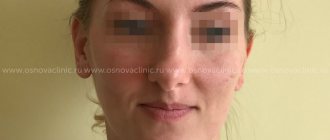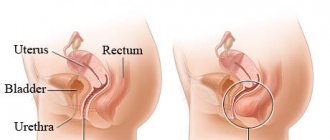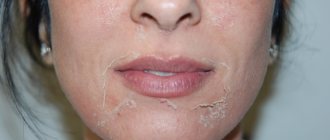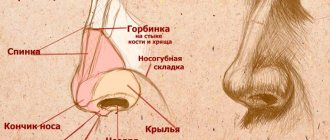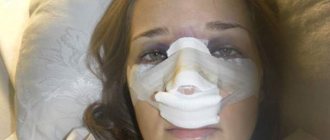Plaster application after rhinoplasty
Many people are unhappy with the shape of their nose, and therefore go under the knife, no matter what. And until they wake up after anesthesia, they don’t even suspect how difficult the first week and a half after the operation will be. The first thing that awaits the patient:
- hematomas on the face;
- swelling;
- painful sensations.
And this is only a small part of what has to be endured. You have to sleep on your back so that your head is as high as possible. There are turundas in the nose that interfere with breathing, and the most corrected nose has plaster on it. This is what irritates many people. But, as it turned out, this is not just a way to fix the operated olfactory organ. This is also a method to avoid severe complications.
Plaster after rhinoplasty allows you to:
- Maintain the shape that the surgeon gave the organ.
- Avoid severe swelling.
- Reduce the appearance of hematomas.
- Helps reduce bleeding.
- Protects against infections.
Such “decoration” must be endured not for the sake of the doctor’s whim, but for one’s own health. Plaster after rhinoplasty does not look very beautiful in the photo, but with its help you will speed up your functional recovery.
After what period is the plaster removed?
The question of when the cast is removed after rhinoplasty is relevant for everyone who has had or plans to have rhinoplasty. This is not surprising, because it causes inconvenience, does not allow you to return to work, fully walk outside, or engage in physical exercise.
When the plaster will be removed depends on the individual patient's indications
In most cases, before removing the plaster, the turundas are removed; this is done after 24 days have passed from the date of the operation. If any contraindications are found, the plaster may be removed only after 72 hours. Plaster is a more serious protection, so it is recommended to wear it for 8-10 days. But after removing such a device, swelling will still be observed, this phenomenon is considered normal.
Is it possible to do without plaster?
Many surgeons recommend not to put a plaster on the nose, but to use a special medical splint to maintain the shape. This is a bandage that is durable and can protect even from severe damage. It is recommended to wear the splint for the same amount of time as the cast.
Although both the cast and the splint bring inconvenience and unpleasant sensations, they must be worn. This will allow you to achieve the maximum result from the operation.
Why an integrated approach is needed
Unpleasant sensations in the joints are explained by the fact that a damaged nerve can transmit pain to nearby tissues. Sometimes surgeons refer a neurologist for additional consultation, but often it is possible to manage with classical treatment and rehabilitation techniques. To return metabolism in damaged areas to normal, you will need an integrated approach of measures, some of which are performed by the patient independently, and some of which are performed in a hospital setting.
The recovery period depends on the severity of the fracture, but this period is not measured in days. In the best case, we are talking about weeks; in the worst case, when there is a history of displacement of bone fragments, rehabilitation can drag on for several months.
The process of removing plaster after rhinoplasty
After the specified time has passed from the moment of the operation and the application of the plaster, they come to the plastic surgeon to remove the plaster.
After rhinoplasty, it is contraindicated to independently manipulate this medical attribute. There are many reasons for this. You can introduce an infection into the affected area and worsen your own health. But the most important thing: you can nullify all the results of the correction. And then you shouldn’t blame the doctor, because it was the patient who, through his actions, led to such an outcome.
When rhinoplasty is performed, removal of the cast is strictly contraindicated, even after a ten-day period, if the doctor decides to prolong walking in it. With the help of a medical attribute, you save deformed tissues from external influences and damage. Plaster is always combined with tampons, which are inserted into the nasal passages. All this will interfere with breathing and cause significant discomfort. You need to be patient and wait.
Types of rhinoplasty
Correction of the tip of the nose
Plastic surgery of the tip of the nose allows you to make it thinner or wider, change the protrusion or angle in relation to the upper lip. The operation consists of internal incisions, manipulation of cartilage and soft tissue, including the columella. After rhinoplasty, the tip of the nose takes on the desired shape and size.
Correction of the nasal septum
Surgery on the nasal septum is called septoplasty. A deviated nasal septum can be either a congenital defect or the result of an injury.
Septum correction is carried out today using laser technology, as well as the traditional endoscopic method. Straightening the septum with a laser is the least traumatic method to avoid bleeding. And the endoscopic method of straightening the nasal septum provides excellent aesthetic results and reduces the duration of the rehabilitation period.
The operation is indicated for those who suffer from:
- deviated nasal septum,
- snoring,
- sinusitis,
- chronic inflammation of the sinuses (sinusitis),
- regular nosebleeds,
- allergic diseases.
Plastic surgery of the wings of the nose (nostrils)
The correction is carried out under both local and general anesthesia. Rhinoplasty can take 2 hours or more. To reduce the nostrils, part of the wings is removed from the outside or in the passage area. In some cases, both of these methods are used. If the nostrils are retracted after an injury, their support is restored. For correction, the patient's cartilage tissue taken from the nasal septum or auricle is used.
What should you not do while wearing a cast?
Many people do not understand that a doctor's advice must be taken seriously. This is due to the fact that you not only must maintain the resulting shape of the nose, but also your own health. The risk of complications is especially high during the rehabilitation period in the first two stages. The most important of them is wearing a cast for a week or more.
In order not to introduce an infection into the operated area, not to injure already damaged tissues and not to spoil the work of the plastic surgeon, we recommend adhering to the following “don’ts”.
Contraindicated when wearing a cast on the nose:
- Taking a shower in general. You will have to wash your body and head separately so as not to wet the bandages and cause them to become deformed.
- You will have to forget for a while about the pool, going to the sauna.
- Heavy physical activity and sports are prohibited.
- Prolonged sneezing is also contraindicated. Here you will have to learn how to do it through your mouth.
- Sleep on your stomach or face down.
- Remove, adjust or do anything else with the plaster yourself.
When rhinoplasty is done and the cast is removed, the doctor will then tell the patient how to behave during the rehabilitation period. It is likely that at first it will still be difficult to breathe. After removing the plaster, you will have to rinse your nasal passages daily with the utmost care. For about three more months, patients will see swelling and bruising in the mirror. But if you had not had a cast on from the very beginning, the symptoms would have been more pronounced, the swelling would have spread to the cheeks and neck to a significant extent. We recommend following your doctor's advice exactly so that the results obtained are worth the effort and patience.
Repositioning of the nasal bones
For fractures of the external and internal parts of the nose, reduction is performed. This is a surgical treatment method in which displaced bones are realigned. With the help of reposition in our medical center, doctors restore the process of nasal breathing disrupted by injury and restore the anatomical position of the bones. The manipulation is performed by experienced doctors after examination using modern diagnostic methods.
SIGNS OF FRACTURE OF THE NOSE BONES
Fractures of the nasal bones occur after various injuries:
- careless exercise;
- car crashes;
- fights or falls.
A clear sign of a broken or displaced bone is severe nosebleeds. This is due to damage to the mucous membrane and rupture of the blood vessels in the nasal cavity.
Other signs of a fracture:
- pain in the nose and adjacent tissues, aggravated by palpation;
- difficulty breathing through the nose due to internal swelling;
- swelling of the tissues adjacent to the nose;
- organ deformations of various types;
- mucous discharge, often mixed with blood.
When the bones of the nose are displaced, a change in its shape and the appearance of asymmetry of the organ are observed. With an open fracture, the skin of the face is damaged, through which bone fragments are visible.
More than half of all cases of nasal fractures are accompanied by a concussion. Therefore, treatment and bone repositioning are carried out in a hospital.
IN WHAT TIME IS THE REPOSITION PERFORMED?
The date on which surgical treatment will be scheduled depends on how quickly the patient contacted our clinic. If 3-6 hours have passed after the injury, reposition will be carried out immediately. If more than six hours have passed since the injury and swelling has begun to develop, repositioning is carried out a week later. This period is needed so that the swelling subsides and nothing interferes with the manipulation.
The earlier treatment is started, the less likely there are complications. Every patient should know about this.
Our medical center does not perform reduction of nasal fractures in three cases.
- The patient presented three weeks after receiving the injury. During this time, the bones grow together; the situation can only be corrected through surgery.
- There is an open fracture of the nasal septum.
- A second or third degree concussion was detected.
In the latter case, reposition is postponed for a week until the patient’s general condition improves.
PREPARATORY ACTIVITIES
Before surgical treatment, the patient donates blood and urine for tests. Undergoing instrumental examination:
- X-ray of the skull bones;
- computed tomography;
- magnetic resonance imaging.
The last two methods are optional and are prescribed if the X-ray results do not provide a complete picture of the extent of damage to the nasal bones.
CARRYING OUT BONE REPOSITION
In our clinic, local anesthesia is administered before repositioning to eliminate pain. The nasal mucosa is “frozen” using a swab moistened with lidocaine solution. Simultaneously with this measure, lidocaine is injected along the back of the nose, at its base and into the side walls. The anesthetic effect occurs after 10 – 15 minutes.
The surgeon's further actions depend on the nature of the fracture and displacement of the nasal bones.
If the injury was caused by a side impact and the bone has moved to the side, it is reset with the fingers. If the bone has shifted to the left side, the surgeon rests on the convex side of the nose with the thumb of his right hand. The degree of pressure is selected individually, depending on the damage. At the moment of pressure, the patient hears a strong crunch. You should not be afraid of it: this indicates that the bone has returned to its anatomical place. When shifted to the right side, the manipulation is carried out in a similar way, but the surgeon presses on the bulge with the thumb of his left hand.
When hit from the front, the bones are pressed inside the nose. In this case, the treatment tactics are different: the doctor uses a special tool - a surgical elevator. The surgeon inserts it into the nasal passage. The depth of insertion depends on the location of the displaced bones. Then the end of the tool is raised in an upward and forward direction. Under the pressure of the elevator, the bones return to their original place. The surgeon controls the correct alignment of the displaced bones with his fingers.
The doctor will correct a luxated septum with his little finger. A finger is inserted into the patient’s nasal passage from the side to which the septum has shifted. At the same time, the surgeon presses on the outer wall of the nose with his index finger, from the side to which the septum has shifted.
If the methods listed above cannot be used, the doctor performs open reduction. Incisions are made in the skin to provide quick access to the broken bones of the nose. The operation is performed under visual control. In the future, fixation is required using various metal structures.
At the final stage of surgical treatment, gauze turundas are inserted into the nostrils. In our medical center, turundas are lubricated with Vaseline so that they can be removed painlessly in the future. This measure is aimed at stopping bleeding and fixing the bones to avoid their re-displacement.
POSSIBLE COMPLICATIONS
Any surgical intervention can cause complications, regardless of the qualifications of the attending physician. Repositioning of the nasal bones after injury is no exception.
- A common complication is nosebleeds. Stopped with tamponade.
- Incorrect fusion of bones. It occurs due to incomplete reduction for various reasons.
- Post-traumatic deformation of the nose.
The last complication arises from the inability to restore the nasal septum completely during reposition. If possible, it is better to perform rhinoseptoplasty. With this manipulation, the doctor has the opportunity to eliminate the displacement of the nasal bones while simultaneously preventing the formation of cosmetic defects.
To reduce the likelihood of complications after repositioning the nasal bones, the patient should follow the doctor's recommendations. It is not advisable to wear sunglasses for a month. During this period, you need to limit heavy physical activity. If difficulties arise with nasal breathing, the patient should contact the attending physician to select vasoconstrictor drops.
DANGER OF SELF-MEDICATION
Some patients, especially men, are in no hurry to see a doctor if their nose is broken. Attempts to straighten displaced nasal bones lead to various kinds of complications:
- damage to soft tissues from sharp bone fragments;
- improper fusion of bones;
- difficulty breathing;
- nasal deformities;
- development of chronic rhinitis and other diseases.
For these reasons, if you have a broken nose, you should not put off visiting a doctor and rely on your own strength. The cost of eliminating the consequences of self-medication is much higher than the price of restoring the position of the bones by a surgeon.
Make an appointment with a doctor at our medical center using the contact information provided on the website. You will learn more detailed information about the surgical service and undergo a full examination. Repositioning of the nasal bones, performed in our clinic, will restore the organ to its original condition in a short time and at a reasonable price.
Will it be possible to remove the cast without the help of a doctor?
Only those who do not want to spend money on the services of a specialist can remove the plaster themselves. But in this case, the plastic surgeon may refuse to be held responsible for the result obtained from the performed rhinoplasty if he suspects that such actions were carried out. You should not engage in “amateur activities” regarding turundas and seams.
Sometimes there are cases when the splint and plaster come off on their own. In such a situation, it is recommended not to panic, but to immediately contact a specialist. It is strictly forbidden to independently remove bandages that have been secured by a doctor.
What is recommended not to do after removal?
Plaster is a kind of “shield” for a vulnerable respiratory organ that has recently been amenable to rhinoplasty. Such a device is needed to maintain bone and cartilage structures in the required position. Also, such a solution is necessary to protect the respiratory organ from accidental injury. It is recommended to adhere to the main rule - to eliminate any possible risks.
To do this, you should observe the following:
- Avoid using glasses with heavy frames.
- Sleep exclusively on your back.
- Try not to make sudden movements with your hands.
- When driving a car, it is recommended to wear a seat belt.
- Avoid sports, including going to gyms and fitness classes.
- Also, you should not attend various rallies, concerts, and festivals during the first month after removing the cast.
- Do not take public transport during rush hour.
- For facial treatment, it is recommended to use only special tonics and micellar waters. Perform all procedures as carefully as possible.
Such recommendations will help prevent any mechanical damage to the respiratory organ.
Current information from the lips of a plastic surgeon
In order for patients to understand in detail what the procedure for applying and removing plaster looks like, we suggest that you read the interview with the famous Moscow plastic surgeon Gaik Pavlovich Babayan:
What is the purpose of applying a plaster cast after nose surgery?
A plaster cast is necessary to fix bones and tissues, the adjustment of which was carried out during the manipulation process. Thanks to the plaster, the final result that the patient will receive after the operation is formed. This allows you to hold the bone and eliminates the possibility of displacement due to swelling. The plaster also additionally protects the area where the operation was performed from mechanical damage. If plaster is applied incorrectly or at the wrong time, there may be side effects - including the risk of completely losing the shape that was the desired result.
How is plaster applied?
First, the surgeon prepares pieces of the required size using a special bandage with plaster. Adds water to the fabric - the dressing hardens. This type of protective device can consist of 5 levels, each of which plays an important role - it provides an antiseptic effect, protects against injury and various types of damage.
How long do you recommend wearing a cast after surgery?
In 95% of cases, plaster is applied for 7-14 days. After this you can safely remove it. Sometimes you have to change the plaster. This happens extremely rarely, but still occurs due to the patient’s fault. This can happen due to intentional or accidental deformation of the bandage, its loosening, or removal. Also, the plaster cast must be changed if it gets wet during the bath procedures.
Is there any pain during plaster removal and what does the procedure look like?
The procedure for removing the plaster cast is not pleasant, but there is no painful sensation as such, rather just discomfort. The entire procedure will take a professional surgeon 6-10 minutes. The patient sits on the couch, and the doctor takes the necessary instruments and performs the required manipulations. It is very important that the movements are careful and that the bandage comes off as a single layer.
Will there be swelling after removal?
There is no swelling immediately after surgery because it is contained by the bandage. After the fixation is removed, the swelling intensifies. This phenomenon is considered normal and will pass after a certain time.
What to do with the itching that occurs under the bandage?
Itching is a normal consequence of wearing a cast. You'll have to wait a few days. It is strictly forbidden to scratch your nose with various improvised objects, such as a toothpick or tweezers. When performing such manipulations, you can break the bandage and make its fit less tight. This will lead to improper fusion of cartilage and bone structures.
What would you recommend not to do while wearing a cast to get the desired result?
I usually talk about all the recommendations during the consultation. The only thing I would like to emphasize is to try not to drip water onto the bandage. Of course, this is difficult, but if you do not let the plaster come into contact with water, you will be able to achieve the desired result faster, and you will not have to re-apply the bandage.
Stages of rehabilitation
Most patients return to work in about 2-3 weeks. However, it takes about one year to fully recover from a nose job.
The entire rehabilitation period is divided into four main stages. Let's look at each of them in more detail.
Primary
The shortest and most complex. It begins immediately after surgery and ends on days 7-10.
The patient returns home with a bandage or plaster splint and tampons installed in the nasal passages. The latter prevent severe bleeding, and the clip secures the new shape of the nose.
Due to the compression of the soft tissues, the swelling is not too large. But liquid begins to accumulate in neighboring areas. The eyelids become swollen, and when the tear duct is pressed, the eyes may water.
There is usually no severe pain. Body temperature may rise and general weakness may be present.
Since it is almost impossible to breathe through the nose, the oral mucosa quickly dries out. Lips begin to crack. Such simple manipulations as washing and brushing teeth turn into a real problem.
The condition will be alleviated by using medications prescribed by a doctor, as well as following his recommendations:
- sleep on a high pillow and only on your back;
- stay in bed for the first few days;
- do not lean forward or lower your head;
- completely stop smoking and coffee;
- do not drink or eat anything hot;
- do not overheat and avoid strong temperature changes;
- completely eliminate physical activity;
- carefully monitor the hygiene of the nasal cavity;
- do not tear off the formed crusts;
- do not scratch or rub your nose and face with your hands;
- do not wear glasses, including sunglasses;
- do not remove the plaster splint without the surgeon’s permission.
It is very important not to catch a cold during this period. A runny nose, coughing and sneezing can completely negate all the surgeon’s efforts and lead to severe deformation of the nose.
You can't even just blow your nose in the usual way. It is only allowed to very carefully clean your nose with swabs or cotton swabs.
Second
A week after surgery, a second consultation with a plastic surgeon is necessary. He removes all stitches and bandages, preliminary assesses the result and how the recovery process is going.
By this point, the swelling is significantly reduced. Once the cast is removed it will return for a short time.
By about 10-14 days, bruises completely disappear from the face. The seams become almost invisible.
Most people go to work if it does not involve serious physical activity. Otherwise you will have to wait at least another month.
Internal swelling of soft tissues and mucous membranes is still present. It makes breathing difficult, reduces the flow of oxygen and prevents you from getting a good night's sleep.
Many patients experience severe irritation about this. Moreover, it is possible to eliminate swelling with medication only for a couple of hours.
The second stage of recovery is completed approximately a month after surgery. During this period, a number of prohibitions still remain on:
- smoking and drinking alcohol;
- active sports;
- visiting the sauna and solarium;
- swimming in the pool and open water;
- wearing glasses;
- prolonged exposure to the sun;
- taking hot baths.
You can start using decorative cosmetics only after all wounds have completely healed and the crusts have fallen off.
Third
Lasts from the first to the third month from the date of rhinoplasty. Most restrictions are lifted and the patient gradually returns to a normal lifestyle.
Internal swelling goes away, nasal breathing is completely restored. Those who have experienced loss of skin sensitivity notice that the nose again responds to touch.
If the swelling does not go away, with the doctor’s permission, you can start smearing with special products - “Troxevasin”, “Badyagu”, etc. It is also recommended to do massage and physiotherapeutic procedures aimed at accelerating intracellular metabolic processes.
At this stage, the patient must continue to protect himself from extreme cold, overheating, and injury. It is extremely undesirable to start smoking - nicotine narrows the capillaries and slows down regeneration. In addition, it reduces immunity. A runny nose during this period is still dangerous.
Final
Even three months after a successful rhinoplasty, many patients may remain dissatisfied with the final result. Although surgeons warn: to fully enjoy the effect, you will have to wait about a year.
This is exactly how much time is needed for deep tissue restoration. The nose finally takes on a new shape only after 10-12 months.
After a year, all bans are lifted, including on traumatic and contact sports. Still, it is worth remembering that with repeated surgery, rehabilitation lasts longer, and the risks of complications are almost twice as high. So it makes sense to take care of your new beautiful nose.
